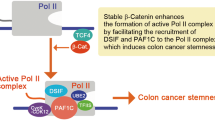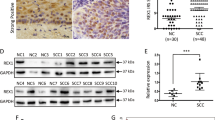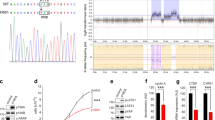Abstract
Activator protein-2 (AP-2) is a transcription factor that regulates proliferation and differentiation in mammalian cells and has been implicated in the acquisition of the metastatic phenotype in several types of cancer. Herein, we examine the role of AP-2α in colon cancer progression. We provide evidence for the lack of AP-2α expression in the late stages of colon cancer cells. Re-expression of the AP-2α gene in the AP-2α-negative SW480 colon cancer cells suppressed their tumorigenicity following orthotopic injection into the cecal wall of nude mice. The inhibition of tumor growth could be attributed to the increased expression of E-cadherin and decreased expression and activity of matrix-metalloproteinase-9 (MMP-9) in the transfected cells, as well as a substantial loss of their in vitro invasive properties. Conversely, targeting constitutive expression of AP-2α in AP-2-positive KM12C colon cancer cells with small interfering RNA resulted in an increase in their invasive potential, downregulation of E-cadherin and increased expression of MMP-9. In SW480 cells, re-expression of AP-2α resulted in a fourfold increase in the activity of E-cadherin promoter, and a 5–14-fold decrease in the activity of MMP-9 promoter, indicating transcriptional regulation of these genes by AP-2α. Chromatin immunoprecipitation assay showed that re-expressed AP-2α directly binds to the promoter of E-cadherin, where it has been previously reported to act as a transcriptional activator. Furthermore, chromatin immunoprecipitation assay revealed AP-2α binding to the MMP-9 promoter, which ensued by decreased binding of transcription factor Sp-1 and changes in the recruitment of transcription factors to a distal AP-1 element, thus, contributing to the overall downregulation of MMP-9 promoter activity. Collectively, our data provide evidence that AP-2α acts as a tumor suppressor gene in colon cancer.
This is a preview of subscription content, access via your institution
Access options
Subscribe to this journal
Receive 50 print issues and online access
$259.00 per year
only $5.18 per issue
Buy this article
- Purchase on Springer Link
- Instant access to full article PDF
Prices may be subject to local taxes which are calculated during checkout








Similar content being viewed by others
Abbreviations
- AP-2α:
-
activator protein-2α
- EMSA:
-
electrophoretic mobility shift assay
- GAPDH:
-
glyceraldehyde-3-phosphate dehydrogenase
- MMP-9:
-
metalloproteinase-9
- ChIP:
-
chromatin immunoprecipitation
References
Bar-Eli M . (2001). Gene regulation in melanoma progression by the AP-2 transcription factor. Pigment Cell Res 14: 78–85.
Batsche E, Muchardt C, Behrens J, Hurst HC, Cremisi C . (1998). RB and c-Myc activate expression of the E-cadherin gene in epithelial cells through interaction with transcription factor AP-2. Mol Cell Biol 18: 3647–3658.
Boedefeld II WM, Bland KI, Heslin MJ . (2003). Recent insights into angiogenesis, apoptosis, invasion, and metastasis in colorectal carcinoma. Ann Surg Oncol 10: 839–851.
Bosher JM, Totty NF, Hsuan JJ, Williams T, Hurst HC . (1996). A family of AP-2 proteins regulates c-erbB-2 expression in mammary carcinoma. Oncogene 13: 1701–1707.
Comijin J, Berx G, Vermassen P, Verschueren K, van Grunsven L, Bruyneel E et al. (2001). The two-handed E box binding zinc finger protein SIP1 downregulates E-cadherin and induces invasion. Mol Cell 7: 1267–1278.
Gershenwald JE, Summer W, Calderon T, Wang Z, Huang S, Bar-Eli M . (2001). Dominant-negative transcription factor AP-2 augments SB-2 melanoma tumor growth in vivo. Oncogene 20: 3363–3375.
Gum R, Lengyel E, Juarez J, Chen JH, Sato H, Seiki M et al. (1996). Stimulation of 92-kDa gelatinase B promoter activity by ras is mitogen-activated protein kinase kinase 1-independent and requires multiple transcription factor binding sites including closely spaced PEA3/ets and AP-1 sequences. J Biol Chem 271: 10672–10680.
Hilger-Eversheim K, Moser M, Schorle H, Buettner R . (2000). Regulatory roles of AP-2 transcription factors in vertebrate development, apoptosis and cell-cycle control. Gene 260: 1–12.
Ho AT, Voura EB, Soloway PD, Watson KL, Khokha R . (2001). MMP inhibitors augment fibroblast adhesion through stabilization of focal adhesion contacts and up-regulation of cadherin function. J Biol Chem 276: 40215–40224.
Huang S, Jean D, Luca M, Tainsky MA, Bar-Eli M . (1998). Loss of AP-2 results in downregulation of c-KIT and enhancement of melanoma tumorigenicity and metastasis. EMBO J 17: 4358–4369.
Huang S, Mills L, Mian B, Tellez C, McCarty M, Yang XD et al. (2002). Fully humanized neutralizing antibodies to interleukin-8 (ABX-IL8) inhibit angiogenesis, tumor growth, and metastasis of human melanoma. Am J Pathol 161: 125–134.
Jean D, Gershenwald JE, Huang S, Luca M, Hudson MJ, Tainsky MA et al. (1988). Loss of AP-2 results in up-regulation of MCAM/MUC18 and an increase in tumor growth and metastasis of human melanoma cells. J Biol Chem 273: 16501–16508.
Karjalainen JM, Kellokoski JK, Eskelinen MJ, Alhava EM, Kosma VM . (1998). Downregulation of transcription factor AP-2 predicts poor survival in stage I cutaneous malignant melanoma. J Clin Oncol 16: 3584–3591.
Melnikova VO, Mourad-Zeidan AA, Lev DC, Bar-Eli M . (2006). Platelet-activating factor mediates MMP-2 expression and activation via phosphorylation of cAMP-response element-binding protein and contributes to melanoma metastasis. J Biol Chem 281: 2911–2922.
Mitchell PJ, Timmons PM, Hebert JM, Rigby PW, Tjian R . (1991). Transcription factor AP-2 is expressed in neural crest cell lineages during mouse embryogenesis. Genes Dev 5: 105–119.
Morikawa K, Walker SM, Nokajima M, Pathak S, Jessup JM, Fidler IJ . (1998). In vivo selection of highly metastatic cells from surgical specimens of different primary human colon carcinomas implanted into nude mice. Cancer Res 48: 6863–6871.
Moser M, Imhof A, Pscherer A, Bauer R, Amselgruber W, Sinowatz F et al. (1995). Cloning and characterization of a second AP-2 transcription factor: AP-2 beta. Development 121: 2779–2788.
Pellikainen J, Naukkarinen A, Ropponen K, Rummukainen J, Kataja V, Kellokoski J et al. (2004). Expression of HER2 and its association with AP-2 in breast cancer. Eur J Cancer 40: 1485–1495.
Pellikainen MJ, Pekola TT, Ropponen KM, Kataja VV, Kellokoski JK, Eskelinen MJ et al. (2003). p21WAF1 expression in invasive breast cancer and its association with p53, AP-2, cell proliferation, and prognosis. J Clin Pathol 56: 214–220.
Ropponen KM, Kellokoski JK, Lipponen PK, Pietilainen T, Eskelinen MJ, Alhava EM et al. (1999). p21/WAF1 expression in human colorectal carcinoma: association with p53, transcription factor AP-2 and prognosis. Br J Cancer 81: 133–140.
Ropponen KM, Kellokoski JK, Pirinen RT, Moisio KI, Eskelinen MJ, Alhava EM et al. (2001). Expression of transcription factor AP-2 in colorectal adenomas and adenocarcinomas; comparison of immunohistochemistry and in situ hybridisation. J Clin Pathol 54: 533–538.
Rozen P . (2004). Cancer of the gastrointestinal tract: early detection or early prevention? Eur J Cancer Prev 13: 71–75.
Ruiz M, Pettaway C, Song R, Stoeltzing O, Ellis L, Bar-Eli M . (2004). Activator protein 2alpha inhibits tumorigenicity and represses vascular endothelial growth factor transcription in prostate cancer cells. Cancer Res 4: 631–638.
Sato H, Seiki M . (1993). Regulatory mechanism of 92 kDa type IV collagenase gene expression which is associated with invasiveness of tumor cells. Oncogene 8: 395–405.
Sumigama S, Ito T, Kajiyama H, Shibata K, Tamakoshi K, Kikkawa F et al. (2004). Suppression of invasion and peritoneal carcinomatosis of ovarian cancer cells by overexpression of AP-2alpha. Oncogene 23: 5496–5504.
Tellez C, Bar-Eli M . (2003). Role and regulation of the thrombin receptor (PAR-1) in human melanoma. Oncogene 22: 3130–3137.
Tellez C, McCarty M, Ruiz M, Bar-Eli M . (2003). Loss of activator protein-2alpha results in overexpression of protease-activated receptor-1 and correlates with the malignant phenotype of human melanoma. J Biol Chem 21: 46632–46642.
Tummala R, Romano RA, Fuchs E, Sinha S . (2003). Molecular cloning and characterization of AP-2 epsilon, a fifth member of the AP-2 family. Gene 321: 93–102.
Vainio H, Miller AB . (2003). Primary and secondary prevention in colorectal cancer. Acta Oncol 42: 809–815.
Wajapeyee N, Somasundaram K . (2003). Cell cycle arrest and apoptosis induction by activator protein 2α (AP-2α) and the role of p53 and p21WAF1/CIP1 in AP-2a-mediated growth inhibition. J Biol Chem 52: 52093–52101.
West-Mays JA, Sivak JM, Papagiotas SS, Kim J, Nottoli T, Williams T et al. (2003). Positive influence of AP-2alpha transcription factor on cadherin gene expression and differentiation of the ocular surface. Differentiation 71: 206–216.
Williams T, Admon A, Luscher B, Tjian R . (1988). Cloning and expression of AP-2, a cell-type-specific transcription factor that activates inducible enhancer elements. Genes Dev 2: 1557–1569.
Yan C, Wang H, Aggarwal BB, Boyd DD . (2004). A novel homologous recombination system to study 92 kDa type IV collagenase transcription demonstrates that the NF-kappaB motif drives the transition from a repressed to an activated state of gene expression. FASEB J 18: 540–551.
Zeng YX, Somasundaram K, El-Deiry WS . (1997). AP2 inhibits cancer cell growth and activates p21WAF1/CIP1 expression. Nat Genet 15: 78–82.
Zhao F, Satoda M, Licht JD, Hayashizaki Y, Gelb BD . (2001). Cloning and characterization of a novel mouse AP-2 transcription factor, AP-2delta, with unique DNA binding and transactivation properties. J Biol Chem 276: 40755–40760.
Acknowledgements
This work was supported by National Institutes of Health grant CA-76098.
Author information
Authors and Affiliations
Corresponding author
Rights and permissions
About this article
Cite this article
Schwartz, B., Melnikova, V., Tellez, C. et al. Loss of AP-2α results in deregulation of E-cadherin and MMP-9 and an increase in tumorigenicity of colon cancer cells in vivo. Oncogene 26, 4049–4058 (2007). https://doi.org/10.1038/sj.onc.1210193
Received:
Revised:
Accepted:
Published:
Issue Date:
DOI: https://doi.org/10.1038/sj.onc.1210193
Keywords
This article is cited by
-
Crucial role of the transcription factors family activator protein 2 in cancer: current clue and views
Journal of Translational Medicine (2023)
-
Epigenetically modified AP-2α by DNA methyltransferase facilitates glioma immune evasion by upregulating PD-L1 expression
Cell Death & Disease (2023)
-
Comprehensive analysis of the expression and prognosis for TFAP2 in human lung carcinoma
Genes & Genomics (2020)
-
The effects of shRNA-mediated gene silencing of transcription factor SNAI1 on the biological phenotypes of breast cancer cell line MCF-7
Molecular and Cellular Biochemistry (2014)
-
AP-2α suppresses invasion in BeWo cells by repression of matrix metalloproteinase-2 and -9 and up-regulation of E-cadherin
Molecular and Cellular Biochemistry (2013)



